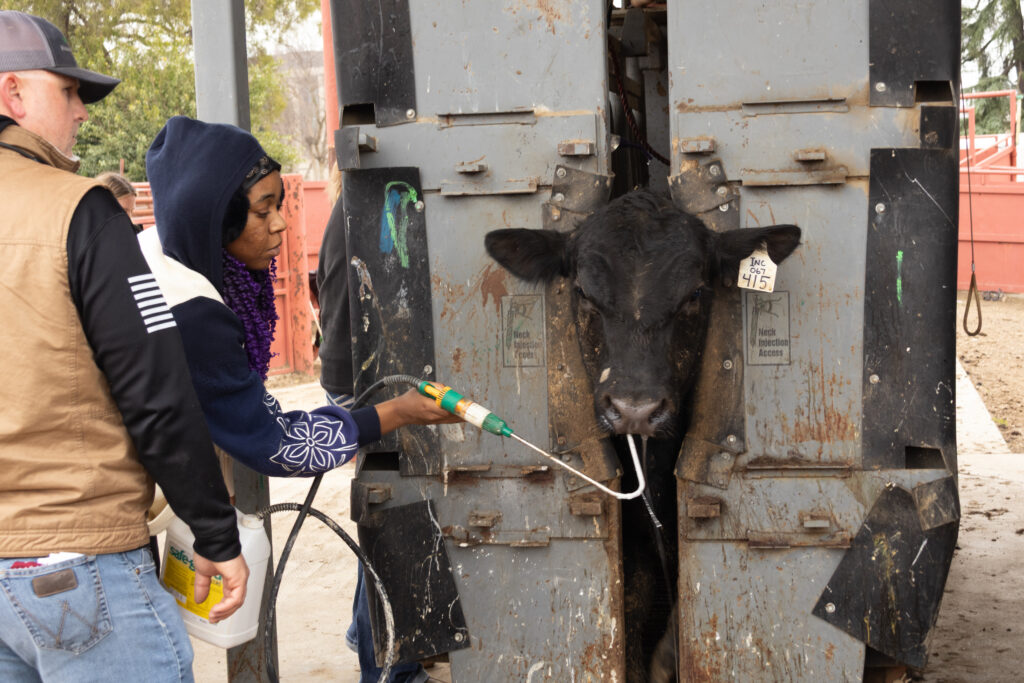
A student at Rocketship Public Schools in San Jose works on a math problem.
Credit: Andrew Reed / EdSource
Top Takeaways
- Charter schools’ enrollment has grown slowly since the pandemic; they now serve one out of eight TK-12 children in California.
- Most charter schools will seek renewal within the next three years under new rules.
- High-profile cases of fraud have led to calls for tighter controls, with bills now before the Legislature.
California charter schools are having a strong year — at least by one metric: enrollment. As the state’s traditional public school population continues to decline, charter school enrollment has risen to nearly 728,000 students, accounting for 12.5% of all public school students across 1,280 campuses and independent study programs.
Most charter schools are also performing well academically. In the 2023-24 California School Dashboard, 16.5% of charter schools earned the highest performance rating, qualifying them for renewals of five to seven years. An additional 76.8% are eligible for five-year renewals, while just 6.7% face closure.
However, this growth comes amid increasing scrutiny. State lawmakers are pushing for stricter financial oversight following high-profile fraud cases, while local districts now have more authority to reject charter petitions. Teachers unions are gaining influence within charter schools.
Looming is the potential for another religious charter school case making its way to the U.S. Supreme Court, adding more complexity to the already politically charged environment. If the court rules in favor of taxpayer funding of religious charter schools, it could have significant implications for public education funding and policy at the state level. Combined with the uncertainty over the future of the U.S. Department of Education and the Trump administration’s support for private school vouchers, the charter school sector faces political challenges not unlike those of 1992, when California enacted its charter school legislation.
The tension is annoyingly familiar to Myrna Castrejón, president and CEO of the California Charter Schools Association (CCSA). Despite charter schools’ successes in academic achievement, dual high school and community college enrollment, and competitive admission rates to the University of California and California State University for Black, Latino, and low-income students, Castrejón described the current political climate as a “bare-knuckle” fight.
“Every year we have to rally our troops and tell our stories and speak to legislators about who we are and who we serve and why our mission is so important,” said Castrejón. “I can’t sit here and say charter schools are doing great and the politics are better — they are not. Make no mistake, we still have opponents who are not going to stop until they strip out our autonomy entirely and/or cripple us.”
Fraud and oversight
A key focus of that anger is Assembly Bill 84, introduced by Assemblymember Al Muratsuchi, D-Torrance, who chairs the Assembly Education Committee. The bill aims to enact sweeping anti-fraud reforms proposed in a trio of reports released last year, following the largest charter school fraud in California history.
Muratsuchi, who is running for state superintendent of public instruction in 2026, told EdSource that he has no intention of “going after the charter schools that are acting responsibly and providing good educational services for their kids.” AB 84, he added, “is about going after the bad actors that are committing fraud and engaging in corruption through the current lack of transparency and accountability that we have with our statewide charter oversight system.”
The most notorious case involved A3 Education, a network of 19 virtual schools whose operators stole over $400 million in public school money by falsifying student enrollments. A3 exploited “a completely failed system not designed and operated to protect itself from theft,” said Kevin Fannan, a former San Diego County deputy district attorney who worked on the case. While this was an extreme case, charter advocates acknowledge the sector’s vulnerabilities and are among those calling for stronger safeguards.
“We are not in denial that we have a problem,” said Eric Premack, founder of the Charter Schools Development Center (CSDC). “It’s extraordinarily painful for us to have even a slow drip of these.” But Premack, Castrejón and other charter advocates believe that Senate Bill 414, which they sponsored, offers a more targeted solution than AB 84, which they view as imposing onerous administrative provisions that have nothing to do with fraud. Both bills have passed their respective houses and will ultimately be amended before a final version is approved and sent to Gov. Gavin Newsom.
Nonclassroom-based schools’ rapid growth
The rapid expansion of “nonclassroom-based” charter schools presents challenges in regulation, but the term itself is a “misnomer,” according to the Legislative Analyst’s Office (LAO) and the Fiscal Crisis and Management Assistance Team (FCMAT) in their anti-fraud report commissioned by the state Legislature. Under state law, a charter school is classified as nonclassroom-based if less than 80% of instruction occurs in a traditional classroom. As a result, hybrid programs, like those that require students to attend classes three days a week, fall into the same category as entirely virtual schools.
For example, Northern Summit Academy (NSA) in rural Shasta County converted a former grocery store in Anderson into a dynamic learning hub for its 200 independent study students in transitional kindergarten through high school. The school offers optional in-person instruction in core subjects like math, social studies and science, as well as an enviable maker space with career technical education in fields such as digital embroidery, video production and robotics.
The academy also provides career pathways in nursing, cosmetology, energy and power, and has a veterinary assistant program with state-of-the-art equipment that has a 100% employment rate for graduates. Students meet weekly, in person or online, with their teacher of record. Despite this hands-on learning, NSA is classified as nonclassroom-based. The LAO-FCMAT report found that nearly two-thirds of nonclassroom-based schools in 2023-24 used hybrid models where much of the instruction was in person.
That still leaves more than 100,000 students in schools that are mainly virtual, and more are expected to seek authorization when a legislative moratorium on new nonclassroom-based charters ends on Jan. 1, 2026. These schools have attracted the most scrutiny due to their disproportionate problems with oversight, especially when authorized by small districts that stand to receive substantial income in oversight fees, which “raised some red flags for us about whether we can have quality authorizing in that situation,” explained Edgar Cabral, the LAO’s deputy legislative analyst for K–12 education. The LAO-FCMAT report identified 14 small districts in 2022-23 that authorized virtual charters whose enrollment far exceeded their district’s own, including most of the six districts conned by the founders of A3 schools.
AB 84 seeks to limit enrollment in nonclassroom-based schools authorized by small districts, but critics argue this could undermine well-run programs and stifle the innovation that is a hallmark of the charter school movement.
Kevin Humphrey, superintendent of Guajome Park Academy, based in Vista in Central California, notes that hybrid programs are essential for students who cannot thrive in traditional settings, offering flexibility for those facing anxiety, health issues or bullying. “These programs don’t just protect our students — they give them a future,” Humphrey said.
Local vs. county
About 84% of charter schools are authorized by local school boards. Nearly all the rest are under county offices of education. A few dozen that are authorized by the State Board of Education have until 2028 to find new authorizers under Assembly Bill 1505. Approved in 2019, AB 1505 was a sweeping charter reform aimed at giving local districts more control over charter authorizations. But there is growing concern among charter critics that more petitioners will bypass local school boards and turn to county offices, which are seen as more charter-friendly.
Adam Weinberger, president of the California School Employees Association, the union representing school staff, decried it as a “blatant end run around local school boards,” undermining the intent of AB 1505.
Adding to the pressure, more than 1,000 charter schools are due for renewal over the next three years due to a pandemic-era pause. This renewal process is a highly detailed and time-consuming task that will strain both local school districts and county offices of education. The rigorous evaluations required for renewals will assess each school’s academic performance, financial stability and legal compliance.
Shrinking enrollment, increasing competition
Ten to 15 years ago, large urban districts saw charter schools as a solution to overcrowded classrooms and split sessions. Now, with statewide enrollment at 5.8 million and declining, districts are competing with charters for a shrinking pool of students. Los Angeles Unified School District (LAUSD), which once enrolled nearly 672,000 students, now serves fewer than 517,000, with charter students making up a record 28% of that total, costing the district about $2.8 billion in state funding. In recent years, the LAUSD board has become more wary of charters and is currently in a legal battle over its efforts to restrict charter schools from sharing campus space with district schools.
Assemblymember Muratsuchi recognized that some districts with declining enrollments have “significant consternation with local charter schools taking away enrollment and enrollment-based funding.” But he also acknowledged that many families choose charter schools and “that is a reality that school districts need to deal with.”
To win back and hold onto students, some districts are expanding choice programs, such as magnet schools and independent study programs. During the 2023-24 school year, more than 277,000 students in transitional kindergarten through 12th grade were receiving at least half their instruction through independent programs run by districts and county offices of education, according to the California Department of Education.
While charter enrollment is still rising, the pace has slowed, as has the number of new schools; only 12 opened in 2023 compared to 53 in 2019. Some long-running charters are closing due to enrollment declines. Downtown College Prep, which opened its first charter high school in San Jose in 2001, shut that campus and its two middle schools last month, citing a $4.5 million budget shortfall and a 35% drop in enrollment in six years.
Pondering this trend, Tom Hutton, executive director of the California Charter Authorizing Professionals, wonders if there will come a point in declining enrollment environments “where, even though choice is impactful, there just are too many schools — both district and charter — creating more risks of making all of them weaker instead of strengthening public education overall.”
At this time, the organization’s most pressing concern is helping authorizers as they face political and public pressure to improve authorizing practices. Its mission is ensuring that charter students receive a high-quality education.
“Charter schools were introduced to inject some new energy into addressing persistent challenges in California’s education system, especially for students with unique needs and those in underserved communities, and in many ways they have succeeded,” Hutton said.
But, as the nation’s largest and second-oldest charter system, he added, “We’re experiencing growing pains and challenges in finding the right balance between continuing to innovate and committing to greater accountability. We see that as an opportunity to strengthen the system.”
Kathryn Baron is an education reporter based in California.







